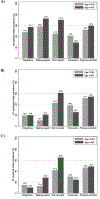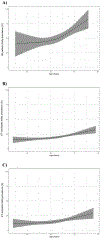Frailty Prevalence in Younger End-Stage Kidney Disease Patients Undergoing Dialysis and Transplantation
- PMID: 32640462
- PMCID: PMC7442041
- DOI: 10.1159/000508576
Frailty Prevalence in Younger End-Stage Kidney Disease Patients Undergoing Dialysis and Transplantation
Abstract
Background: Frailty, originally characterized in community-dwelling older adults, is increasingly being studied and implemented for adult patients with end-stage kidney disease (ESKD) of all ages (>18 years). Frailty prevalence and manifestation are unclear in younger adults (18-64 years) with ESKD; differences likely exist based on whether the patients are treated with hemodialysis (HD) or kidney transplantation (KT).
Methods: We leveraged 3 cohorts: 378 adults initiating HD (2008-2012), 4,304 adult KT candidates (2009-2019), and 1,396 KT recipients (2008-2019). The frailty phenotype was measured within 6 months of dialysis initiation, at KT evaluation, and KT admission. Prevalence of frailty and its components was estimated by age (≥65 vs. <65 years). A Wald test for interactions was used to test whether risk factors for frailty differed by age.
Results: In all 3 cohorts, frailty prevalence was higher among older than younger adults (HD: 71.4 vs. 47.3%; candidates: 25.4 vs. 18.8%; recipients: 20.8 vs. 14.3%). In all cohorts, older patients were more likely to have slowness and weakness but less likely to report exhaustion. Among candidates, older age (odds ratio [OR] = 1.79, 95% CI: 1.47-2.17), non-Hispanic black race (OR = 1.30, 95% CI: 1.08-1.57), and dialysis type (HD vs. no dialysis: OR = 2.06, 95% CI: 1.61-2.64; peritoneal dialysis vs. no dialysis: OR = 1.78, 95% CI: 1.28-2.48) were associated with frailty prevalence, but sex and Hispanic ethnicity were not. These associations did not differ by age (pinteractions > 0.1). Similar results were observed for recipients and HD patients.
Conclusions: Although frailty prevalence increases with age, younger patients have a high burden. Clinicians caring for this vulnerable population should recognize that younger patients may experience frailty and screen all age groups.
Keywords: Age; Dialysis; End-stage kidney disease; Frailty; Kidney transplantation.
© 2020 S. Karger AG, Basel.
Conflict of interest statement
DISCLOSURE STATEMENT
The authors have no conflicts of interest to declare.
Figures



References
Publication types
MeSH terms
Grants and funding
LinkOut - more resources
Full Text Sources
Medical

